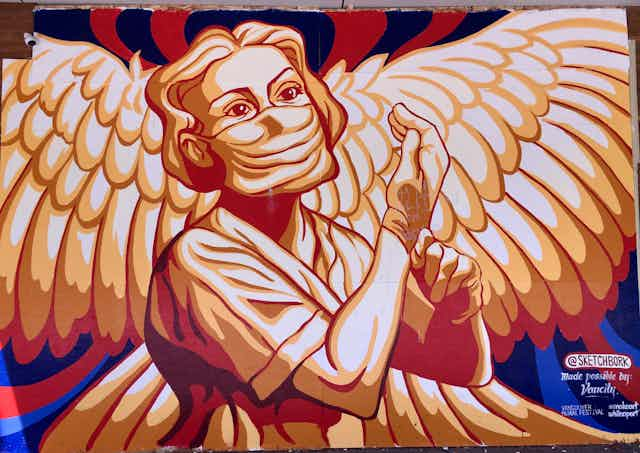Urban public spaces have been transforming during the COVID-19 pandemic. Storefronts in once-bustling shopping districts have been boarded up with plywood. In many cities, large temporary boards have gradually been painted with murals.
In Vancouver, B.C., there are three types of new murals: inspirational works of general encouragement and gratitude toward essential workers; informational murals, conveying warnings and advice; and decorative, largely abstract, paintings adding colour to the plywood.
Cities have always had street art, but what should we make of these recent murals? Our research looks at how public space is essential to political debate about urban futures.
In our critical reading of the COVID-19 murals, the artists are expressing specific visions of the future. Our analysis also raises questions about whose visions for the future are less evident in the murals.
Murals tell stories and are political
Thin veneers of paint on walls, murals seem one-dimensional. Yet, they reference and resonate across numerous aspects of life. Murals take up space.
They often commemorate and glorify particular stories of the past, like conservative tales of empire or the “good old days.” Murals also memorialize victims of injustice — as the ones for George Floyd have done. These murals are intended to inspire progressive change and they celebrate movements that have fought for that change.

Murals are also future-oriented. They invoke opportunities and desired social change. Thus, they are political. Researchers and activists pay attention to murals as harbingers of gentrification, as indicators of local economic development priorities, as grassroots pedagogy and as expressions of struggles over the city.
Murals tell stories that are shaped by their artists and funders. They represent partial stories about what is important in the world and who is an important member of the public.
COVID-19 murals
In Vancouver, officially curated murals have been painted by local artists during the crisis. They’re commissioned and supported by the city, store owners, business improvement associations, the local Mural Festival organization, a graffiti removal company and a credit union.
Inspirational murals, like the masked angelic health professional by Will Phillips in downtown Vancouver, represent the care and professional competence of health-care and other essential workers. These murals often contain portraits of individuals or small groups in monumental, heroic or even quasi-religious poses. They feature personal care workers who, until recently, may have been taken for granted.

Informational murals convey advice. For example, artist Smokey D’s mural, a collaboration with community advocate Karen Ward, advises physical distancing, frequent hand-washing, less face-touching and provides statistics on the global impact of the virus. Funded by the city and located in Vancouver’s Downtown Eastside, home to many people with health vulnerabilities, this mural is part of a wider ecosystem of grassroots outreach work, as well as traditional sources of news.
Compared to inspirational murals, informational ones often encourage self-help and awareness for survival.
Decorative murals are less likely to emphasize a message or an individual. Instead, they tend to mirror the esthetic of the retail store on which they are painted, either in their colour scheme or motifs. Their purpose is to make shuttered retail streetscapes more attractive, thus encouraging customers to return, while leaving the interpretation of the art up to their audience. They avoid taking a stand that might alienate any viewers.

Reading and re-writing the city
Urban geographers have long approached the city as a text or canvas that can be read to understand how it is shaped by political, economic, social and cultural forces and values.
Reading the murals commissioned by local government and business allows us to see a heightened appreciation of care work; a commitment to the well-being of the most vulnerable, and a concern about the future of brick-and-mortar retail.
Yet, official narratives are only part of the story. While these murals reflect approved messages, images, values and agendas, other artists, painting and creating in less official capacities, are mainly left out of the picture, with less resources. Thus, their messages are less likely to gain public attention.

There are no critiques of housing precarity, health-care funding or income inequality in the officially sanctioned murals.
This is not to say the commissioned murals are apolitical. The inspirational and informational murals contain latent calls for increased public funding for public health care, decent housing and social services for essential workers and for people who are low-income earners.
The decorative murals may raise questions about the long-term value and viability of urban shopping districts. Their presence may subtly ask passersby if they are willing to find public solutions to the threat of e-commerce.
Murals are remarkably ephemeral. Unless maintained assiduously, they quickly fade. COVID-19 murals are particularly fleeting, since they are painted on temporary hoardings. Similarly, supportive feelings about essential workers, vulnerable neighbours and local businesses, can quickly fade, especially when other economic priorities arise.
Public art invites us to think about what stories are being told to us — and by whom. We should also be aware of the stories we are not being told. Art can offer this sort of comprehensive, critical reading of the world and its possible futures. It can inspire progressive political coalitions to work toward a more just society. If they succeed, an artist will paint them in a mural one day.

